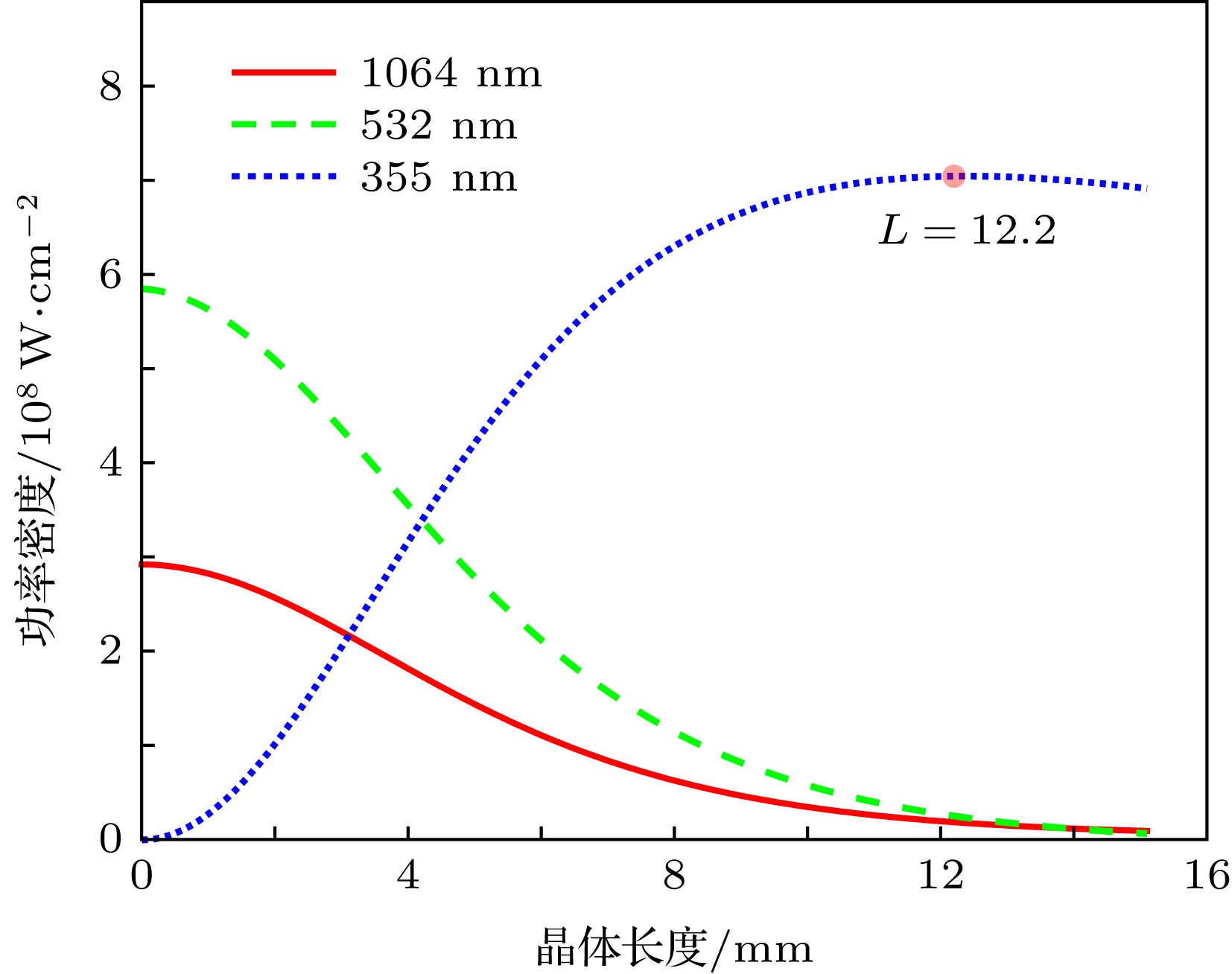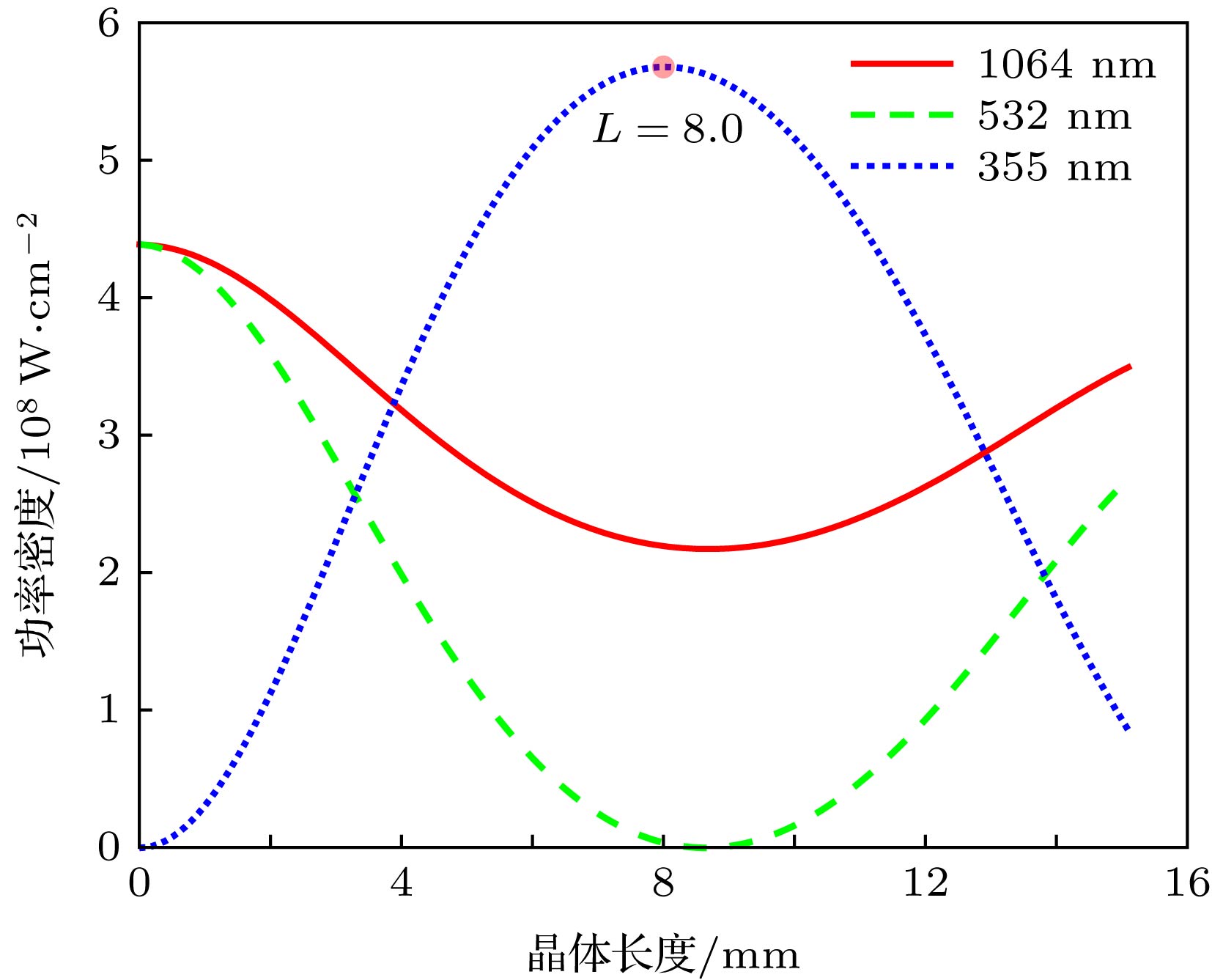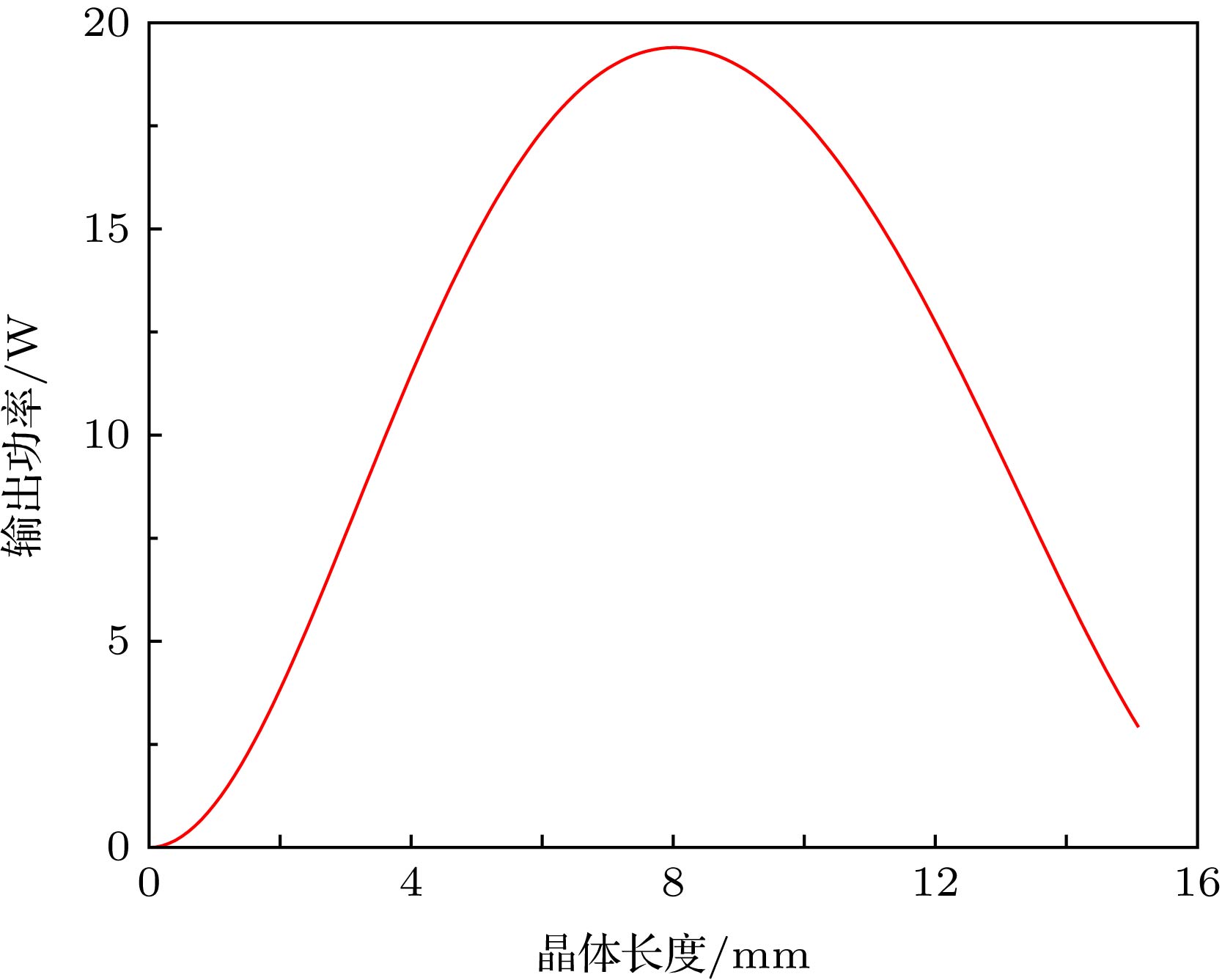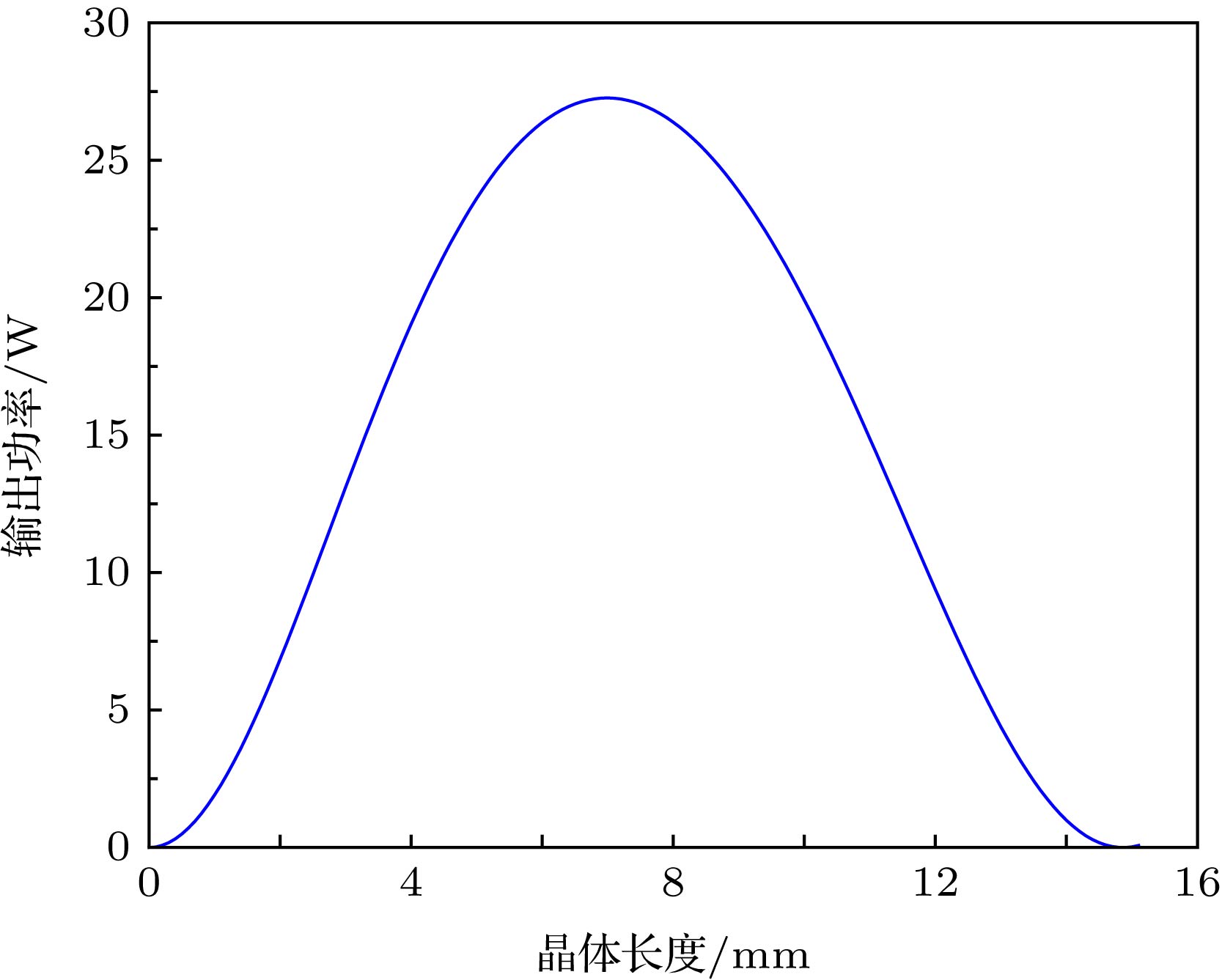-
在腔外和频获得紫外355 nm皮秒激光输出的过程中, 和频晶体的长度是影响转换效率的重要因素. 和频过程的激光输入参数和晶体吸收系数都会影响和频晶体的最适长度选取. 目前缺乏对于腔外和频产生紫外355 nm激光过程中输入激光光子数配比以及晶体吸收对于和频晶体最适长度影响的研究. 本文基于三波耦合方程进行了理论推导和数值模拟, 讨论了不同入射条件下最高和频效率的稳态解, 分析了不同光子数配比以及LiB3O5晶体吸收对于最适和频晶体长度的影响, 提出了放大基频光同时缩短晶体长度并提高转换效率的方案. 在该方案中, 将1064 nm皮秒基频光在倍频产生532 nm二次谐波后进行分离放大, 再与532 nm倍频光在LiB3O5晶体内进行和频, 从而产生紫外355 nm皮秒激光输出. 模拟结果表明, 通过基频放大改变和频过程中的光子数配比, 可以缩短取得最高转换效率的和频晶体最适长度, 同时减少和频晶体对于355 nm激光的吸收和走离影响, 输出功率较传统方案提升40%以上, 从而获得了高效率紫外355 nm皮秒激光输出.
-
关键词:
- 紫外皮秒355 nm激光 /
- 和频 /
- 基频光放大 /
- LiB3O5晶体
In recent years, picosecond laser in ultraviolet (UV) has manifested great importance for applications both in science and industry, such as biomedical research, micro machining, etc. Now, the well proven approach to generating ultra-short UV pulses is extra-cavity frequency conversion based on nonlinear optical (NLO) crystal, due to the lack of suitable laser sources directly generating UV laser. In this process of harmonic generation, the length of nonlinear crystal is an important factor affecting the conversion efficiency and beam-quality. The optimal length of the nonlinear crystal is influenced by incident laser parameters and crystal absorption coefficient. At present, for the UV 355 nm picosecond laser generated from extra-cavity sum frequency, published are few reports about detailed analysis and research on the influence of photon ratio of the incident laser beams and nonlinear crystal absorption on optimal length of sum frequency crystal. In this paper, the steady-state solutions with the highest conversion efficiency under different incident conditions are obtained by theoretical analysis and numerical simulation of the three waves coupling equations. The effects of different photon ratios and absorption effect of the sum frequency crystal on the optimum crystal length are analyzed. We propose a solution based on the fundamental frequency laser amplified to shorten crystal length and improve conversion efficiency. In this scheme, the 532 nm second harmonic laser with a high conversion efficiency over 65% can be achieved by LiB3O5 crystal. After that, the 1064 nm fundamental frequency laser is separated from the second harmonic laser, and then it is amplified by the Nd:YVO4 laser crystal pumped by an 808 nm laser diode. Finally, the ultraviolet 355 nm picosecond laser is obtained by combining the 1064 nm fundamental frequency laser with the 532 nm second harmonic laser in the LiB3O5 crystal. The simulation results show that the incident photon ratio of the sum frequency reaction can be changed by amplifying the residual fundamental frequency laser, and the optimum length of the sum-frequency crystal corresponding to the highest conversion efficiency can be shortened. Meanwhile, the absorption and walk-away effect of the sum frequency crystal can be also reduced. The final 355 nm laser output power can be increased more than 40 percent compared with the traditional scheme of early reports. In consequence, the high sum frequency conversion efficiency of the UV 355 nm picosecond laser can be obtained by changing the photo ratio of the incident laser beams through amplifying the fundamental frequency laser.-
Keywords:
- ultraviolet picosecond 355 nm laser /
- sum frequency /
- fundamental frequency laser amplified /
- LiB3O5 crystal
[1] Klein-Wiele J H, Bekesi J, Simon P 2004 Appl. Phys. A: Mater. Sci. Process. 79 775
 Google Scholar
Google Scholar
[2] Chen T C, Darling R B 2008 J. Mater. Process. Technol. 198 248
 Google Scholar
Google Scholar
[3] Norreys P A, Zepf M, Moustaizis S, Fews A P, Zhang J, Lee P, Bakarezos M, Danson C N, Dyson A, Gibbon P, Loukakos P, Neely D, Walsh F N, Wark J S, Dangor A E 1996 Phys. Rev. Lett. 76 1832
 Google Scholar
Google Scholar
[4] Gray R J, Yuan X H, Carroll D C, Brenner C M, Coury M, Quinn M N, Tresca O, Zielbauer B, Aurand B, Bagnoud V, Fils J, Kühl T, Lin X X, Li C, Li Y T, Roth M, Neely D, McKenna P 2011 Appl. Phys. Lett. 99 171502
 Google Scholar
Google Scholar
[5] Raith A, Perkins W T, Pearce N J G, Jeffries T E 1996 Fresenius' J. Anal. Chem. 355 789
[6] Ubachs W, Eikema K S E, Hogervorst W, Cacciani P C 1997 J. Opt. Soc. Am. B 14 2469
 Google Scholar
Google Scholar
[7] Francis A L, Warner J W, Telfair W B, Yoder P R, Martin C A 1989 Arch. Ophthalmol. 107 131
 Google Scholar
Google Scholar
[8] Sharp D G 1939 J. Bacteriol. 37 447
[9] Rastogi V K, Wallace L, Smith L S 2007 Mil. Med. 172 1166
 Google Scholar
Google Scholar
[10] Craxton R S 1980 Opt. Commun. 34 474
 Google Scholar
Google Scholar
[11] Hodgson N, Dudley D, Gruber L, Jordan W, Hoffman H 2001 Summaries of papers presented at the Conference on Lasers and Electro-Optics Baltimore, MD, USA, May 11, 2001 p389
[12] Wang C X, Wang G Y, Hicks A V, Dudley D R, Pang H Y, Hodgson N 2006 Solid State Lasers XV: Technology and Devices (Vol. 6100) (San Francisco: SPIE) p610019
[13] Zhu P, Li D, Liu Q, Chen J, Fu S, Shi P, Du K, Loosen P 2013 Opt. Lett. 38 4716
 Google Scholar
Google Scholar
[14] Yap Y K, Inagaki M, Nakajima S, Mori Y, Sasaki T 1996 Opt. Lett. 21 1348
 Google Scholar
Google Scholar
[15] Zhang J, Wang L, Wu Y, Wang G, Fu P, Wu Y 2011 Opt. Express 19 16722
 Google Scholar
Google Scholar
[16] Zhang J, Wang L, Li Y, Wang G, Zhang G, Wu Y 2012 Opt. Express 20 16490
 Google Scholar
Google Scholar
[17] Li K, Zhang L, Xu D, Zhang G, Yu H, Wang Y, Shan F, Wang L 2014 Opt. Lett. 39 3305
 Google Scholar
Google Scholar
[18] 尤晨华, 范琦康, 陆祖康, 尤桂铭 1989 光学学报 9 401
 Google Scholar
Google Scholar
You C H, Fan Q K, Lu Z Q, You G M 1989 Acta Opt. Sin. 9 401
 Google Scholar
Google Scholar
[19] Ueda K, Orii Y, Takahashi Y, Okada G, Mori Y, Yoshimura M 2016 Opt. Express 24 30465
 Google Scholar
Google Scholar
[20] Huang J Y, Shen Y R, Chen C, Wu B 1991 Appl. Phys. Lett. 58 1579
 Google Scholar
Google Scholar
[21] Armstrong J A, Bloembergen N, Ducuing J, Pershan P S 1962 Phys. Rev. 127 1918
 Google Scholar
Google Scholar
[22] 姚建铨 1995 非线性光学频率变换及激光调谐技术 (北京: 科学出版社) 第69页
Yao J Q 1995 Technic of Nonlinear Optical Frequency Conversion and Laser Tunable Technic (Beijing: Science Press) p69 (in Chinese)
-
表 1 不同功率密度配比M条件下峰值转换效率对应的晶体长度
Table 1. Crystal lengths corresponding to the peak conversion as to different power density ratios M
M 1∶2 2∶2 3∶2 4∶2 5∶2 晶体长度/mm 12.2 7.0 5.4 4.6 4.1 -
[1] Klein-Wiele J H, Bekesi J, Simon P 2004 Appl. Phys. A: Mater. Sci. Process. 79 775
 Google Scholar
Google Scholar
[2] Chen T C, Darling R B 2008 J. Mater. Process. Technol. 198 248
 Google Scholar
Google Scholar
[3] Norreys P A, Zepf M, Moustaizis S, Fews A P, Zhang J, Lee P, Bakarezos M, Danson C N, Dyson A, Gibbon P, Loukakos P, Neely D, Walsh F N, Wark J S, Dangor A E 1996 Phys. Rev. Lett. 76 1832
 Google Scholar
Google Scholar
[4] Gray R J, Yuan X H, Carroll D C, Brenner C M, Coury M, Quinn M N, Tresca O, Zielbauer B, Aurand B, Bagnoud V, Fils J, Kühl T, Lin X X, Li C, Li Y T, Roth M, Neely D, McKenna P 2011 Appl. Phys. Lett. 99 171502
 Google Scholar
Google Scholar
[5] Raith A, Perkins W T, Pearce N J G, Jeffries T E 1996 Fresenius' J. Anal. Chem. 355 789
[6] Ubachs W, Eikema K S E, Hogervorst W, Cacciani P C 1997 J. Opt. Soc. Am. B 14 2469
 Google Scholar
Google Scholar
[7] Francis A L, Warner J W, Telfair W B, Yoder P R, Martin C A 1989 Arch. Ophthalmol. 107 131
 Google Scholar
Google Scholar
[8] Sharp D G 1939 J. Bacteriol. 37 447
[9] Rastogi V K, Wallace L, Smith L S 2007 Mil. Med. 172 1166
 Google Scholar
Google Scholar
[10] Craxton R S 1980 Opt. Commun. 34 474
 Google Scholar
Google Scholar
[11] Hodgson N, Dudley D, Gruber L, Jordan W, Hoffman H 2001 Summaries of papers presented at the Conference on Lasers and Electro-Optics Baltimore, MD, USA, May 11, 2001 p389
[12] Wang C X, Wang G Y, Hicks A V, Dudley D R, Pang H Y, Hodgson N 2006 Solid State Lasers XV: Technology and Devices (Vol. 6100) (San Francisco: SPIE) p610019
[13] Zhu P, Li D, Liu Q, Chen J, Fu S, Shi P, Du K, Loosen P 2013 Opt. Lett. 38 4716
 Google Scholar
Google Scholar
[14] Yap Y K, Inagaki M, Nakajima S, Mori Y, Sasaki T 1996 Opt. Lett. 21 1348
 Google Scholar
Google Scholar
[15] Zhang J, Wang L, Wu Y, Wang G, Fu P, Wu Y 2011 Opt. Express 19 16722
 Google Scholar
Google Scholar
[16] Zhang J, Wang L, Li Y, Wang G, Zhang G, Wu Y 2012 Opt. Express 20 16490
 Google Scholar
Google Scholar
[17] Li K, Zhang L, Xu D, Zhang G, Yu H, Wang Y, Shan F, Wang L 2014 Opt. Lett. 39 3305
 Google Scholar
Google Scholar
[18] 尤晨华, 范琦康, 陆祖康, 尤桂铭 1989 光学学报 9 401
 Google Scholar
Google Scholar
You C H, Fan Q K, Lu Z Q, You G M 1989 Acta Opt. Sin. 9 401
 Google Scholar
Google Scholar
[19] Ueda K, Orii Y, Takahashi Y, Okada G, Mori Y, Yoshimura M 2016 Opt. Express 24 30465
 Google Scholar
Google Scholar
[20] Huang J Y, Shen Y R, Chen C, Wu B 1991 Appl. Phys. Lett. 58 1579
 Google Scholar
Google Scholar
[21] Armstrong J A, Bloembergen N, Ducuing J, Pershan P S 1962 Phys. Rev. 127 1918
 Google Scholar
Google Scholar
[22] 姚建铨 1995 非线性光学频率变换及激光调谐技术 (北京: 科学出版社) 第69页
Yao J Q 1995 Technic of Nonlinear Optical Frequency Conversion and Laser Tunable Technic (Beijing: Science Press) p69 (in Chinese)
计量
- 文章访问数: 12827
- PDF下载量: 167
- 被引次数: 0













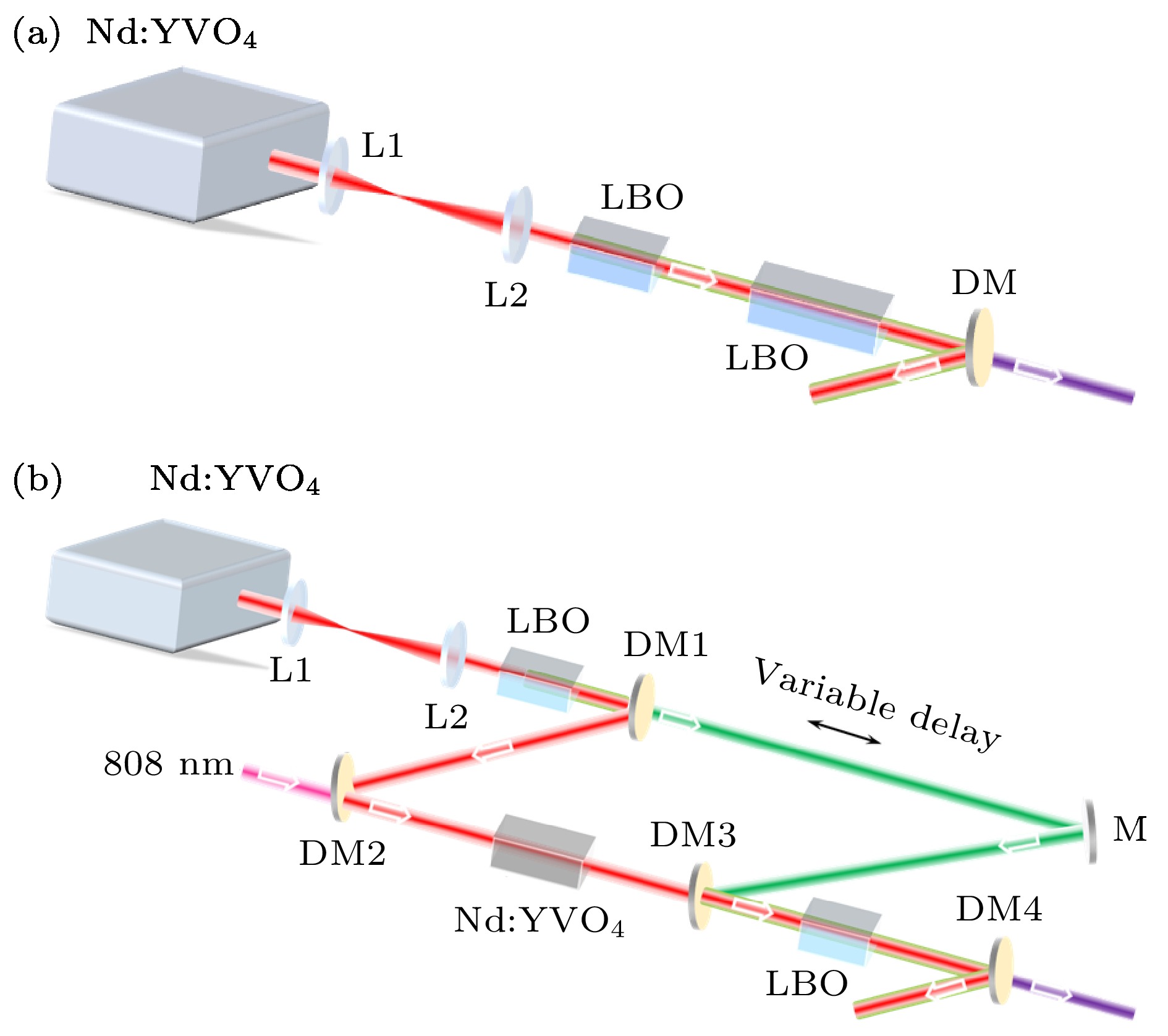
 下载:
下载:
